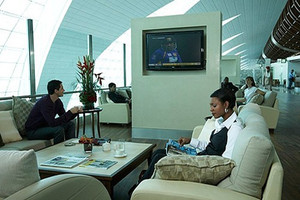
It is early on a warm winter morning as our motor coach speeds along the highway. To the east of us lies the Indian Ocean, its balmy waters sparkling in the dappled sunlight, while the backdrop to the west is the rugged Hajar Mountain range, its limestone peaks subtly changing colour with every twist in the near empty road. I’m touring Fujairah, a holiday destination which is a less well known member of the United Arab Emirates, and which straddles the eastern edge of the country on the Gulf of Oman. Its name means “where the sun rises” in Arabic, and as I soon discovered, it strikes a bold contrast with its more glitzy neighbours. Instead of stark desert, Fujairah has lush green valleys, mountain ranges dotted with oases which tumble into the ocean, and empty sandy beaches. An unexploited jewel of alluring landscapes, it also boasts an impressive collection of forts and castles offering a glimpse into its ancient past.
Al Bidyah Mosque
While it may lack some of the gloss and glamour of its more famous neighbours, as I discovered, the tiny Emirate of Fujairah is a mix of dramatic landscapes and subdued charm. I was visiting the Persian Gulf on a cruise, and along with visiting Abu Dhabi and Dubai, our ship had ventured into a few less well known Arabian ports of call; Fujairah being one. Our day-long exploration began with a stop at one of its most revered holy sites, the Al Bidyah Mosque. Located at the side of the road between Dibba and Khor Fakkan, it’s the oldest mosque in the UAE dating back to 1446. Unlike many of its predecessors, however, it has an unusual and fragile architecture, constructed of mud bricks and plaster with four domes supported by an internal pillar and no minaret.
Our next destination was a lookout over Fujairah’s Wadi Wuraya, a scenic spot and protected region of environmental importance. To get there our motor coach followed the coast passing small villages, beaches bustling with working fishermen, and the famous Dibba Mosque with its distinctive tiled dome. Eventually, we turned inland towards the lower ranges of the Hajar Mountains. En route, our guide gave us an insight into the history of the Emirate, and more importantly, perhaps, its significance today. Although it’s one of the poorer states, it has a key location on the Gulf of Oman outside the Straits of Hormuz, the narrow and strategically important channel separating Oman and the UAE from Iran to the north.
Wadi Wuraya
Progress has seen Fujairah succumb to development in recent, but it clings to its past as one of the less relaxed Emirates. Tourists have to obey Sharia laws; consumption of alcohol is strictly controlled, women need to cover up, and kissing in public is frowned upon. Soon we are at the look out. Wadi is an Arabic word for valley, and as scenic spots go this lush region isn’t what you expect of a country on the Arabian peninsula. Besides valuable water resources, Wadi Wuraya is also home to over 300 plant species, a variety of insects and animals, and it’s rich in archeological treasures.
After time to stretch our legs and take photographs, we headed to famous Friday Masafi Market, or the Souq al Juma as it is known locally. Located on the Dubai-Fujairah Road, local traders gather daily to sell everything from rugs, carpets and earthenware, to plants and foods. Unlike traditional souqs, which often occupy chaotic lane ways, this market flanks either side of the highway stretching for a quarter of a kilometre. It was a great opportunity to mingle with the locals and learn some good-natured bargaining tips, as heavy trucks hurtled past transporting goods from Fujairah port to the other Emirates.
Al Bithna Fort
En route to Fujairah Fort and Museum we stopped briefly to photograph the famous Al Bithna Fort. An impressive structure built in 1735, it once stood watch over the strategic route across the Hajar Mountains through the Wadi Ham, and was one of the most important fortresses in the eastern part of the UAE. Another important structure, and one of the country’s most photographed, however, is Fujairah Fort, our last stop on the tour. The building you see today, however, is a replica; standing on a hill and dating back to 1670, it was badly damaged in the early twentieth century by the British, but has been renovated to its former glory. We arrived back at the port of Fujairah as the sun began to set, the outline of the Hajar Mountains lingering in the softening light. Unlike red hot Dubai or flamboyant Abu Dhabi, Fujairah’s mood is decidedly quieter, providing both a respite and a cultural contrast for its visitors.
- By:
- Joanna Hall













